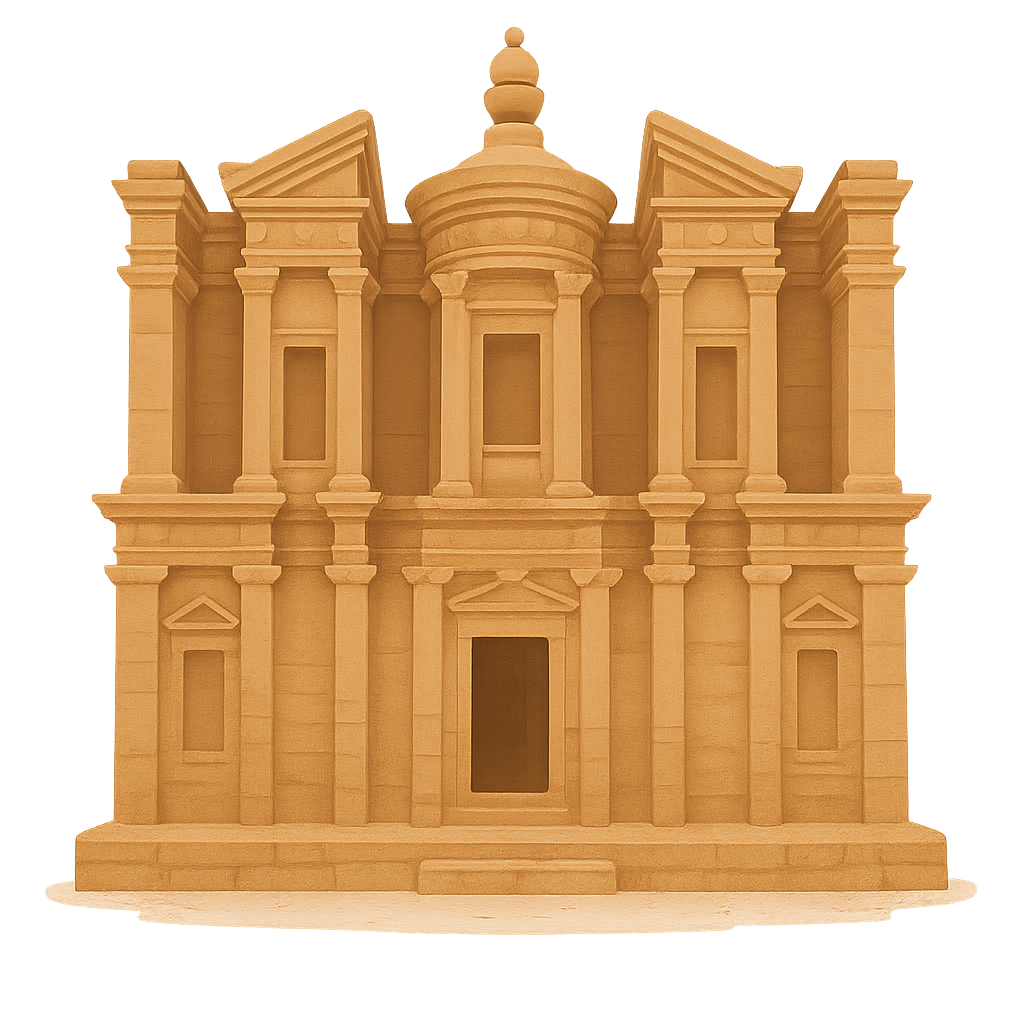The Rose-Red City's Secret
Imagine you are walking through a narrow crack in the earth, a deep canyon so tall that the sky is just a sliver of blue above you. The walls of this winding passage, called the Siq, are not plain rock. They are swirling masterpieces of red, pink, orange, and sandstone, sculpted by wind and time into smooth, flowing shapes. With every step, the air grows cooler and the silence deeper, broken only by the echo of your footsteps. You walk for more than a kilometer, the anticipation building with each turn. You sense you are approaching something magnificent, a secret hidden from the world. Then, through the final sliver of the canyon, you see it. A breathtaking facade, intricately carved into the cliff face itself, glows in the sunlight. Columns, statues, and urns are all part of the solid rock, a building that wasn't built, but unveiled. I am Petra, the rose-red city, half as old as time.
My story begins with a clever and resourceful people called the Nabataeans. They were masters of the desert, traders who commanded the ancient routes that crossed the vast sands. Around 312 BCE, they were looking for a capital city—a place that was safe, secret, and could support a thriving population. They found me. This hidden valley, accessible only through the narrow Siq, was a natural fortress. But it was in a desert, and a city cannot live without water. This is where the Nabataeans showed their genius. They became brilliant engineers, studying the patterns of the rare desert rains. They carved intricate channels, dams, and enormous underground cisterns directly into the rock. They captured every precious drop of water, directing it throughout the city to supply fountains, gardens, and homes for over 20,000 people. Because of their ingenuity, I became a bustling oasis. Camel caravans, their bells jingling, arrived daily. They carried fragrant frankincense from Oman, rare spices from India, and fine silks from China. I was a crossroads of culture and commerce, a wealthy kingdom carved from stone and sustained by water.
For centuries, I flourished as the heart of the Nabataean kingdom. But the world is always changing. In the year 106 CE, a new power arrived: the Roman Empire. The Romans were powerful, but they were also great builders. They did not destroy me. Instead, they added to my beauty. They paved a grand Colonnaded Street, built a massive theater that could seat thousands, and added temples and arches in their own style. Nabataean and Roman culture blended, and for a time, I was more magnificent than ever. But my fortunes began to change. Traders discovered that it was faster and cheaper to transport their goods by sea, bypassing my desert routes. The caravans came less and less often. Then, in the year 363 CE, the earth shook violently. A devastating earthquake crumbled many of my buildings and, most importantly, destroyed the complex water channels that were my lifeline. Without a steady supply of water and trade, life became too difficult. Slowly, over many years, my people began to leave, and the once-bustling streets grew quiet.
For more than a thousand years, I fell into a long, quiet sleep. The wider world forgot about me, and my grand tombs and temples were known only to the local Bedouin tribes who sheltered in my caves and knew my every secret. My entrance remained hidden, my story a whispered legend. Then, in 1812, a young Swiss explorer named Johann Ludwig Burckhardt was traveling through the region. He was fascinated by local stories of a lost city. Disguising himself in local attire and claiming he wished to make a sacrifice at a nearby tomb, he persuaded a guide to lead him through the secret canyon. I can still remember his gasp of awe as he emerged from the Siq and laid eyes on my Treasury for the first time. He knew he had found something extraordinary. He couldn't stay long, but he carefully recorded what he saw in his journal. His writings reintroduced me to the world, and soon, travelers and archaeologists began the journey to witness my wonders for themselves.
Today, my sleep is over, and my stone halls once again echo with the footsteps and voices of people from every corner of the globe. In 1985, I was named a UNESCO World Heritage site, a treasure to be protected for all of humanity. I am no longer a bustling trade hub, but I am still a place of connection. I connect people to the incredible history of the Nabataeans, showing what human beings can achieve with vision and determination. My carved facades, my silent tombs, and my clever water channels are a testament to creativity and resilience in the face of a harsh landscape. When you look at my stones, you are looking at thousands of years of history. I invite you to listen to their stories and remember that the wonders we create can endure, inspiring and connecting people long after we are gone.
Reading Comprehension Questions
Click to see answer
